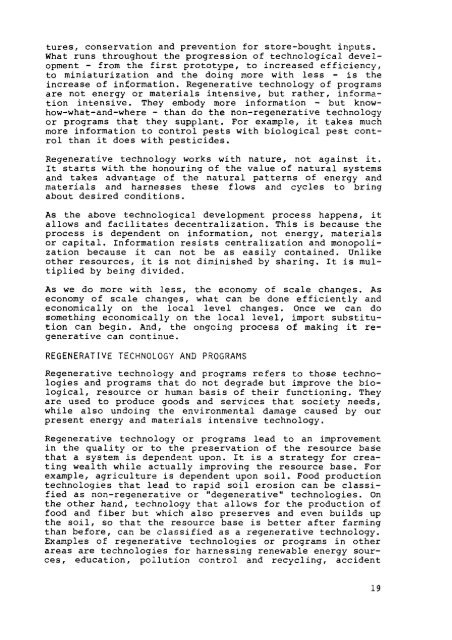Ifda dossier 47, May/June 1985
Ifda dossier 47, May/June 1985
Ifda dossier 47, May/June 1985
You also want an ePaper? Increase the reach of your titles
YUMPU automatically turns print PDFs into web optimized ePapers that Google loves.
tures, conservation and prevention for store-bought inputs.<br />
What runs throughout the progression of technological devel-<br />
opment - from the first prototype, to increased efficiency,<br />
to miniaturization and the doing more with less - is the<br />
increase of information. Regenerative technology of programs<br />
are not energy or materials intensive, but rather, informa-<br />
tion intensive. They embody more information - but know-<br />
how-what-and-where - than do the non-regenerative technology<br />
or programs that they supplant. For example, it takes much<br />
more information to control pests with biological pest cont-<br />
rol than it does with pesticides.<br />
Regenerative technology works with nature, not against it.<br />
It starts with the honouring of the value of natural systems<br />
and takes advantage of the natural patterns of energy and<br />
materials and harnesses these flows and cycles to bring<br />
about desired conditions.<br />
As the above technological development process happens, it<br />
allows and facilitates decentralization. This is because the<br />
process is dependent on information, not energy, materials<br />
or capital. Information resists centralization and monopoli-<br />
zation because it can not be as easily contained. Unlike<br />
other resources, it is not diminished by sharing. It is mul-<br />
tiplied by being divided.<br />
As we do more with less, the economy of scale changes. As<br />
economy of scale changes, what can be done efficiently and<br />
economically on the local level changes. Once we can do<br />
something economically on the local level, import substitu-<br />
tion can begin. And, the ongoing process of making it re-<br />
generative can continue.<br />
REGENERATIVE TECHNOLOGY AND PROGRAMS<br />
Regenerative technology and programs refers to those techno-<br />
logies and programs that do not degrade but improve the bio-<br />
logical, resource or human basis of their functioning. They<br />
are used to produce goods and services that society needs,<br />
while also undoing the environmental damage caused by our<br />
present energy and materials intensive technology.<br />
Regenerative technology or programs lead to an improvement<br />
in the quality or to the preservation of the resource base<br />
that a system is dependent upon. It is a strategy for crea-<br />
ting wealth while actually improving the resource base. For<br />
example, agriculture is dependent upon soil. Food production<br />
technologies that lead to rapid soil erosion can be classi-<br />
fied as non-regenerative or "degenerative" technologies. On<br />
the other hand, technology that allows for the production of<br />
food and fiber but which also preserves and even builds up<br />
the soil, so that the resource base is better after farming<br />
than before, can be classified as a regenerative technology.<br />
Examples of regenerative technologies or programs in other<br />
areas are technologies for harnessing renewable energy sour-<br />
ces, education, pollution control and recycling, accident
















